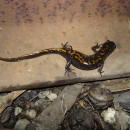About Us
The Farallon Islands National Wildlife Refuge is located on the pacific coast approximately 28 miles west of San Francisco California. Totaling 211 acres, it is composed of several islands in four groups: the North Farallon, Middle Farallon, South Farallon Islands, and Noonday Rock.
The North Farallon, Middle Farallon, and Noonday Rock were designated as the Farallon Refuge by President Theodore Roosevelt in 1909 to protect seabirds and marine mammals. South Farallon Islands is the largest island at 70 acres and was added to the refuge in 1969.
Southeast Farallon is the only island that supports structures from earlier times, several of which have been maintained or renovated for refuge management purposes.
Congress designated all these islands, except Southeast Farallon Island, as the Farallon Wilderness Area in 1974 (Public Law 93-550). The Farallon's are also designated as a State Ecological Reserve and a part of the Golden Gate Biosphere Network.
Marine Life
In 1981, Congress designated the Gulf of the Farallones National Marine Sanctuary, which spanned 1,279 square miles of water surrounding the islands. This sanctuary protects open ocean, nearshore tidal flats, rocky intertidal areas, estuarine wetlands, subtidal reefs, and coastal beaches within its boundaries.
Today, the Greater Farallones National Marine Sanctuary encompasses 3,295 square miles of federally-protected open ocean and coastal waters off the North-central California coast, and is one of the most productive and biodiverse marine ecosystems on the planet! It is home to one of the largest feeding grounds for white sharks, 29 species of whales and dolphins, over 390 species of fish, and over 330 species of invertebrates – deep sea corals, sponges, shrimp, crab and other mollusks and crustaceans and much more.
Our Mission
The mission of the National Wildlife Refuge System is to administer a national network of lands and waters for the conservation, management and, where appropriate, restoration of the fish, wildlife and plant resources and their habitats within the United States for the benefit of present and future generations of Americans.
Our History
In 1539, Spanish explorer Juan Rodriquez Cabrillo may have visited the Islands as he sailed along the California coast. The Spanish named the Farallon Islands in the 1600s. The term Farallon means “cliff” or “small island in the sea”
Later, Sir Francis Drake is speculated to have anchored off the islands to replenish his food supply with seals and birds. In the late eighteenth and nineteenth centuries, Americans and Russians exploited the sea lions, fur seals, and sea otters, found in abundance on the islands, for their pelts.
During California’s gold rush era, California’s population grew, and the Farallon Islands were heavily harvested for seabird eggs. One of the egg companies of the period reputedly gathered and sold close to four million common murre eggs between 1850 and 1856. During the "Egg Wars", fights broke out, guns were drawn, and people were killed over the islands eggs. Restrictions by the Secretary of Interior in 1890 led to the eventual ban of egg harvesting on the Farallons.
In 1855, to prevent shipwrecks and provide navigation safety, the Lighthouse Service constructed the first Fresnel lens lighthouse on South East Farallon Island due to San Francisco’s expansion as a major seaport in the early 1800’s.
In 1903, the U.S. Weather Bureau constructed a weather station on Southeast Farallon Island to broadcast weather reports to the mainland for mariners. The Navy later took control of the station and installed a manned radio station in 1905, which provided a vital communication point during World Wars I and II and the 1906 earthquake.
In 1909, President Theodore Roosevelt established Middle Farallon, the North Farallons, and Noonday Rock as the 24th refuge in the country through Executive Order 1043. South Farallon Island was added in 1969 under Public Land Order 4671.
Biologists from Point Reyes Bird Observatory (PRBO) first visited the islands in 1967 and have maintained a permanent presence since 1968. In 1971, PRBO and the U.S. Fish and Wildlife Service began joint protection, monitoring, research, and management of the Refuge through a cooperative agreement.
Also in 1971, California designated the islands a state refuge up to one nautical mile from the coast line of each island, prohibiting use of firearms and taking of birds and mammals from navigable waters within the refuge.
Today, the waters surrounding the Farallon Islands are managed by the National Oceanic and Atmospheric Administration (NOAA) as part of the Gulf of Farallones National Marine Sanctuary (GFNMS) and the California Department of Fish and Wildlife as the Farallon Islands State Marine Conservation Area.
Other Facilities in this Complex
The Farallon Islands National Wildlife Refuge is managed as part of the San Francisco Bay National Wildlife Refuge Complex. Other refuges in the San Francisco Bay National Wildlife Refuge Complex include: Salinas River, Ellicott Slough, Don Edwards San Francisco Bay, Marin Islands, San Pablo Bay, and Antioch Dunes National Wildlife Refuge.
The Refuge Complex headquarters is located at 1 Marshlands Rd. Fremont, CA. 94555.
A National Wildlife Refuge Complex is an administrative grouping of two or more refuges, wildlife management areas or other refuge conservation areas that are primarily managed from a central office location. Refuges are grouped into a complex structure because they occur in a similar ecological region, such as a watershed or specific habitat type, and have a related purpose and management needs. Typically, a project leader or complex manager oversees the general management of all refuges within the complex and refuge managers are responsible for operations at specific refuges. Supporting staff, composed of administrative, law enforcement, refuge manager, biological, fire, visitor services, and maintenance professionals, are centrally located and support all refuges within the complex.




